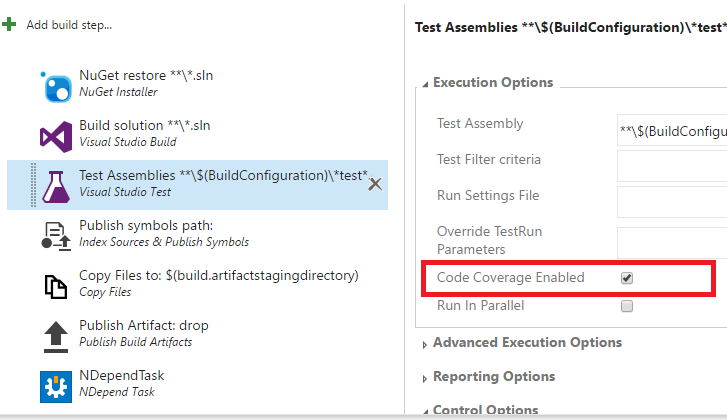

Once you are done with all the required settings, start executing tests pointing to the instrumented Azure service deployed on dev fabric.ĩ.

service endpoints, connection strings etc.Ĩ. After starting dev fabric, run the command csrun /devstore:start in opened “Windows Azure SDK Command Prompt”ħ. Run the command csrun /devfabric:start in opened “Windows Azure SDK Command Prompt”Ħ. Browse the location, Programs->Windows Azure SDK v1.2->Windows Azure SDK Command Prompt and open it in Administrator mode:ĥ. Once you run your Azure solution it will open Internet Explorer.Ĥ. Here, you need to make sure that the coverage monitor is started before deploying the Azure service on dev fabric.ģ.
Check code coverage in visual studio windows#
Open Azure solution and deploy the instrumented Windows Azure service on dev fabric using run key (F5).ĭeploy the Instrumented Windows Azure Service Start coverage monitor by running the command vsperfcmd /start:coverage /output:”My_coverage”.Ģ. To get code coverage for Windows Azure service, you need to first instrument the service by using the steps below.ġ.
Check code coverage in visual studio install#
Install dev fabric (Windows Azure SDK latest).Install Microsoft Visual Studio 2010/2012.You can follow the steps belo9w to set up the environment and collect the code coverage: Pre-requisiteĪs a pre-requisite, you need to install the items below: Microsoft VSTS allows you to follow a set of steps to achieve detailed, line-by-line statistics for which code has been tested and not tested. Steps to Achieve Code Coverage Using VSTSĬode coverage data for Azure services can easily be collected by running test cases on dev fabric using Microsoft VSTS. Improve overall test case quality to test untested code or a complex code piece of product.Easily find dead or unused code, which is not related to the actual requirement.Help in defining the granular level testing strategy to test assembly, namespace and class, etc.Improve the quality of the product to identify the areas that are not covered by test case execution.Benefit of Code CoverageĬode coverage for Windows Azure services is a bit new in the technology world but Microsoft provides a simple and effective way to perform code coverage analysis using VSTS to get all the benefits of it some of them are as follows: In this article, we’ll discuss how code coverage can be done for Windows Azure Service using Microsoft Visual Studio Team Suite (VSTS). If after executing all the test cases still you find that there are code blocks and lines available that are not covered, it means the program or product has not been thoroughly tested.Ĭode coverage helps to improve the quality of testing you can identify the areas where more focus is required to increase the coverage and deliver a quality product. Also, it helps to analyze which parts of a program or product are tested and which are not covered or partially covered by the collection of test cases. Learn More.Ĭode coverage is the way to identify or measure what percentage of the source code of a program or a product has been tested. We may make money when you click on links to our partners. It's not well known but very interesting if you are using unit content and product recommendations are editorially independent. I have entitled this post with Visual Studio 2013 but in fact, this is available since 2008 without much change.

Once clicked, you will see the code changing. To enable this feature, click on the Code Coverage Result the icon with multiple block. Visual Studio and code coverage tool can highlight in green all code that has been reach by unit tests and in red if no test has executed the line. As you can see in the image below, every thing is unit tested (100%).Īnother feature is to display directly into the code which line has been hit and which one has not been hit. What is important is the blue arrow, the project tested. As you can see, event the unit test project is in the statistic (red arrow).

This panel indicates the number of code block and the percentage covered by all code. You can open this panel by going to Test>Windows>Code Coverage Result if you want to open it later. Once done, the Code Coverage Result panel open. Not all edition has this feature, but Premium and Ultimate do.įirst of all, where is the code coverage tool in Visual Studio? It's in the Test menu under Analyze Code Coverage. Microsoft Visual Studio has the ability to tell you what is covered by your unit test.


 0 kommentar(er)
0 kommentar(er)
